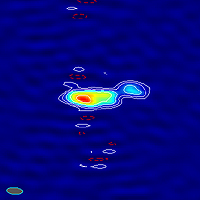CXC Home | Search | Help | Image Use Policy | Latest Images | Privacy | Accessibility | Glossary | Q&A
PKS 0637-752 in Context

Quasars look starlike when viewed through an optical telescope. It wasn't until the 1950's when radio astronomy was first developed, that astronomers realized that they were emitting enormous amounts of radio energy. These objects were named quasars, short for quasi-stellar radio sources. The source of the prodigious energy output of quasars is believed to be a supermassive black hole in the center of a galaxy.
Cosmic jets are a common feature of quasars and active galaxies. They are believed to be produced by enormous electromagnetic forces near the central black hole. One of the most intriguing features of supermassive black holes is that they do not suck up all matter that fall within their sphere of influence. Most of the matter falls inexorably toward the black hole, but some explodes away from the black hole in high-energy jets that move near the speed of light.
Strong evidence in support of this view comes from the image on the left. (See below) This very high resolution image shows a much smaller jet that is only a few light years from the center of the quasar. This image was made by a collaboration of Japanese, Australian and American astronomers using telescopes based in space and on the ground. This images shows a much smaller jet that is one ten-thousandth as long as the larger jet.
Chandra cannot image details this fine, but it may allow astronomers to probe closer to the central black hole because the X-rays from the central source may be produced much closer to the black hole. Understanding how jets are produced and maintained will require a detailed knowledge from both radio and X-ray observations.
Return to PKS 0637-752 (26 Aug 99)



